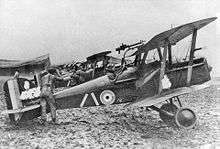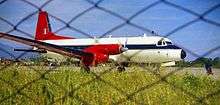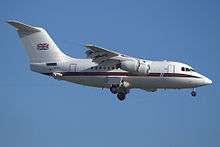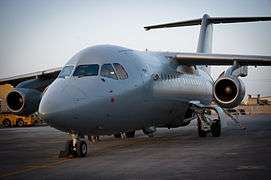No. 32 Squadron RAF
No. 32 (The Royal) Squadron (sometimes written as No. 32 (TR) Squadron) of the Royal Air Force operates in the VIP and general air transport roles from RAF Northolt in Greater London.
| No. 32 (The Royal) Squadron RAF | |
|---|---|
_Squadron_RAF.jpg) | |
| Active |
|
| Country | |
| Branch | |
| Type | Flying squadron |
| Role | Command Support Air Transport |
| Size | Five aircraft |
| Part of | No. 2 Group RAF |
| Home station | RAF Northolt |
| Motto(s) | Adeste Comites (Latin for 'Rally round, comrades')[1] |
| Aircraft | |
| Battle honours |
|
| Commanders | |
| Current commander | Wing Commander Caroline Viles |
| Insignia | |
| Squadron badge heraldry | A hunting horn stringed, representing the unit's ability to hunt the enemy. Approved by King George VI in December 1936.[3] |
| Post 1950 Squadron Roundel |  |
| Squadron Codes | KT (Oct 1938 – Sep 1939) GZ (Sep 1939 – Nov 1942, Jul 1944 – May 1949) |
Originally formed in 1916 as part of the Royal Flying Corps, the squadron saw action during the First and Second World Wars with fighter aircraft, but was disbanded in 1969. The Metropolitan Communications Squadron, involved in the VIP transport role, was renamed as No. 32 Squadron at that time. In 1995, the squadron was merged with the Queen's Flight and incorporated 'The Royal' title into its name. At this time the squadron moved from RAF Benson to RAF Northolt, where it remains.
The merger ended the RAF's provision of dedicated VIP transport aircraft; the aircraft of 32 Squadron are available to VIP passengers only if not needed for military operations. Two flights within the squadron operate the British Aerospace 146 and AgustaWestland AW109 aircraft.
History
Formation

No. 32 Squadron was formed as part of the Royal Flying Corps on 12 January 1916 at Netheravon and moved to France as a fighter squadron equipped with Airco DH.2s in May.[4] On 1 July 1916, its commanding officer, Major Lionel Rees, was engaged in a combat with eight German Albatros two-seaters, and although wounded in the leg, managed to scatter the German aircraft, driving down two of the enemy, for which action he was awarded the Victoria Cross.[4]
The squadron continued to fly patrols over the Western Front, including over the Somme and Arras battlefields, for a year before beginning to re-equip with the Airco DH 5, specialising in ground attack missions. These in turn began to be replaced by the S.E.5a in December 1917 which were flown for the rest of the war on fighter and ground attack missions. On 1 April 1918 No. 32 became part of the new Royal Air Force. In March 1919, the squadron returned to the UK as a cadre and disbanded on 29 December 1919.[5] During the war just ended, sixteen aces had served in its ranks. They included: future Air Marshal Arthur Coningham DSO, MC, DFC; Walter Tyrrell, MC ; Arthur Claydon, DFC; John Donaldson, DSC, DFC, CdG; Wilfred Green, DFC, MM, CdG; Frank Hale, DFC; Hubert Jones, MC, AFC; William Curphey, MC; Maxmillian Mare-Montembault, MC; and George Lawson, DFC.[6]
Inter-war years
The squadron reformed on 1 April 1923 at RAF Kenley as a single flight of Sopwith Snipe fighters.[7] A second flight was formed on 10 December 1923 and a third brought the squadron up to strength on 1 June 1924. Gloster Grebes were received at the end of 1924 and were replaced by Gloster Gamecocks two years later. Equipped in succession with Armstrong Whitworth Siskins, Bristol Bulldogs and Gloster Gauntlets, No. 32 Squadron received the Hawker Hurricane in October 1938.[7]
Second World War
In May 1940, the squadron flew patrols over northern France and took part in the defence of south-east England based at RAF Biggin Hill but operating daily from their forward airfield at RAF Hawkinge, near Folkestone, during the opening weeks of the Battle of Britain. The squadron moved to northern England at the end of August 1940.[8] The squadron's Hurricanes saw little action throughout 1941, but did attempt, unsuccessfully, to escort the Fairey Swordfish biplanes of 825 Naval Air Squadron during their doomed attempt to stop the German warships Scharnhorst, Gneisenau and Prinz Eugen during the Channel Dash on 12 February 1942,[9] and then carried out a number of night intruder operations before being deployed overseas.
Following Operation Torch, the Anglo-American invasion of North Africa, in December 1942, 32 Squadron deployed with its Hurricanes to Algeria, converting to the Supermarine Spitfire by July 1943.[9] Operations included a deployment to Greece, where the squadron took part in the Greek Civil War from September 1944 to February 1945.[7]
Post-war
After the end of the Second World War, the squadron continued as a fighter squadron, flying Spitfires, Vampires and Venoms from bases in Palestine, Cyprus, Egypt, Persian Gulf, Malta and Jordan. In January 1957, the squadron converted to Canberra B.15[10] bombers at RAF Weston Zoyland, flying these from Cyprus, remaining there until disbanding on 3 February 1969.[7]
VIP transport

The Metropolitan Communications Squadron was formed on 8 April 1944 by the renaming of No. 510 Squadron for VIP air transport. Simultaneous with No.32 Squadron being disbanded in Cyprus in February 1969, the Metropolitan Communications Squadron was renamed No. 32 Squadron. It operated a variety of aircraft, including Hawker Siddeley Andovers and Westland Whirlwind HC.10 helicopters.[11]
The squadron acquired four HS.125 CC.1s business jets in 1971. These would be supplemented and then replaced by two HS.125 CC.2s delivered in 1973 and six BAe 125 CC.3s delivered in 1982 and 1983. Aérospatiale Gazelle helicopters served with the squadron from 1976 onwards. These were replaced by initially two (later three) Twin Squirrels in 1996.[12]
The RAF leased two BAe 146s in 1983 (designated BAe 146 CC.1) as a test of their suitability to replace the Andover, which were operated by 241 Operational Conversion Unit. Two BAe 146-100s (designated BAe 146 CC.2) were purchased in 1984 for the Queen's Flight as a result, with delivery in 1986. A third BAe 146 CC.2 was purchased in 1989 and delivered in 1990,[13] although it was subsequently sold in 2002. The BAe 146 provided a 60% increase in range compared with the Andover, and a larger interior capacity for more passengers.[14]

On 1 April 1995, the Queen's Flight, equipped with these BAe 146 CC.2 aircraft, and Wessex HCC.4 helicopters, was merged into No. 32 Squadron to become No. 32 (The Royal) Squadron and moved to RAF Northolt from RAF Benson.[15] Since then, 32 Squadron's aircraft have served as transports in several recent conflicts including Operation Granby (Gulf War), Operation Veritas (Afghanistan) and Operation Telic (Iraq 2003). The merged squadron continues to be referred to in the press and by the public (inaccurately) as the Royal Flight or the Queen's Flight. This merger ended the RAF's provision of dedicated VIP transport aircraft: the aircraft of No. 32 Squadron are available to VIP passengers only if not needed for military operations. This was declared officially in 1999, with the MOD stating: "the principal purpose of 32 Squadron [is] to provide communications and logistical support to military operations; the Squadron's capacity should be based on military needs only; and any royal or other non-military use of ... spare capacity is secondary to its military purpose".[16]
_Squadron._Middlesex._29-05-2002_MOD_45140430.jpg)
Following a review by the Ministry of Defence, in 2004 the squadron's aircraft lost their distinctive livery inherited from The Queen's Flight, featuring red flying surfaces. This was due to the concern over the aircraft's vulnerability to terrorist attack.[15]
In May 2005 the Defence Logistics Organisation's Helicopter and Islander Combined (HIC) Integrated Project Team (IPT) awarded AgustaWestland a five-year contract from 1 April 2006 to provide three AgustaWestland AW109Es to replace the three Twin Squirrels. This contract was extended on 31 March 2011 to allow two of the AW109Es to continue in use for a further year.[17] Two preserved examples of the squadron's ex-Queen's Flight Wessex helicopters can be seen at The Helicopter Museum in Weston-super-Mare and Royal Air Force Museum London.[18]
Two additional BAe 146s were purchased in March 2012 from TNT Airways and were refitted by Hawker Beechcraft on behalf of BAE Systems for tactical freight and personnel transport use.[19][20] The aircraft, designated as the BAe 146 C Mk 3, arrived in Afghanistan in April 2013.[21] On 16 March 2015, the squadron's final BAe 125 returned from operations in Afghanistan, and the type's retirement from the RAF was brought forward due to defence budget cuts.[22] Of the final four operational aircraft, three were put up for sale by the Ministry of Defence,[23] and one was placed on permanent display at RAF Northolt.[24] The decision was made that the aircraft were to be retired from service seven years ahead of their original withdrawal date.[25]
On 11 October 2017, the MoD announced that Her Majesty The Queen has approved the award to 32 (The Royal) Squadron of Battle Honours 'Iraq 2003–2011' and 'Libya 2011', both without the right to emblazon.[26]
Squadron strength

.jpg)
- 'A' Flight
- 'B' Flight
See also
- Air transports of Heads of State
- Air Mobility Command 89th Airlift Wing – United States
- 437 (Husky) Transport Squadron and 412 Transport Squadron – Canada
- No. 42 Squadron RNZAF – New Zealand
- No. 34 Squadron RAAF – Australia
References
Notes
- Pine, L.G. (1983). A dictionary of mottoes (1 ed.). London: Routledge & Kegan Paul. p. 5. ISBN 0-7100-9339-X.
- Unknown 1966, p. 32.
- Halley 1988, pp. 78–79.
- Rawlings 1971, p. 424.
- Rawlings 1971, pp. 424–425.
- "George Lawson". The Aerodrome. Retrieved 16 February 2010.
- Rawlings 1971, pp. 425–426.
- Rawlings 1971, p.426.
- Brookes, Andrew (2014). RAF Canberra Units of the Cold War. Osprey Publishing. p. 63. ISBN 978-1782004110.
- "RAF 32 Squadron Westland Whirlwind HAR.10 XJ407 at RAF Honington". Aviation Photo Company. 1979. Retrieved 23 June 2019.
- "Leonardo Grandnew A109SP". Royal Air Force. Retrieved 23 June 2019.
- Lambert 1993, p. 384.
- "The Aircraft of Royal Air Force Northolt". Royal Air Force. 2012. Retrieved 27 June 2012.
- "Royal planes may lose Union Jack". BBC News. 15 April 2004. Retrieved 27 May 2012.
- National Audit Office Royal travel by air and rail
- "Two A109Es retained by RAF". Air International May 2011, p.7.
- "Westland Wessex In Profile". Haynes. Retrieved 23 June 2019.
- "BAE Systems wins £15.5 million MOD contract for the Royal Air Force". BAE Systems. 21 June 2012. Retrieved 25 June 2012.
- "BAe 146 C.Mk 3 aircraft delivered to the UK Royal Air Force". BAE Systems. 19 April 2013. Retrieved 12 June 2013.
- "BAe146 C Mk 3". Royal Air Force. 29 April 2013. Archived from the original on 30 May 2013. Retrieved 12 June 2013.
- "End Of An Era - Final 32 Sqn BAE125 Returns From Ops". Royal Air Force. 18 March 2015. Archived from the original on 24 September 2015. Retrieved 25 September 2015.
- "Royal Air Force BAe 125 retirement". Global Aviation Resource. 29 March 2015. Retrieved 25 September 2015.
- "New Gate Guardian At RAF Northolt". Royal Air Force. 27 July 2015. Retrieved 25 September 2015.
- Ripley, Tim (7 December 2014). "Six jets axed as Osborne's cuts hit the royal flight". The Sunday Times. Retrieved 25 September 2015.
- "Royal Air Force squadrons recognised for gallantry". GOV.UK. 11 October 2017. Retrieved 12 October 2017.
Bibliography
- Halley, James J. The Squadrons of the Royal Air Force & Commonwealth 1918–1988. Tonbridge, Kent, UK: Air Britain (Historians) Ltd., 1988. ISBN 0-85130-164-9.
- Hobson, Chris. A brief history of 32 Squadron Royal Air Force. 1986
- Jefford, C.G. RAF Squadrons, a Comprehensive Record of the Movement and Equipment of all RAF Squadrons and their Antecedents since 1912. Shrewsbury, Shropshire, UK: Airlife Publishing, 2001. ISBN 1-84037-141-2.
- Lambert, Mark. Jane's All The World's Aircraft 1993–94. Coulsdon, UK: Jane's Data Division, 1993. ISBN 0 7106 1066 1.
- Lewis, Gwilym Hugh. Wings over the Somme. London: William Kimber, 1976. ISBN 0-7183-0324-5. (republished by Bridge Books of Wrexham, Wales in 1994. ISBN 1-872424-38-4.)
- Moyes, Philip J.R. Bomber Squadrons of the RAF and their Aircraft. London: Macdonald and Jane's, 1964 (2nd edition 1976). ISBN 0-354-01027-1.
- Rawlings J.D.R. "History of No. 32 Squadron". Air Pictorial, November 1971, Vol. 33 No. 11. pp. 424–427.
- Rawlings, John. Fighter Squadrons of the RAF and their Aircraft. London: Macdonald and Jane's Publishers Ltd., 1969 (second edition 1976). ISBN 0-354-01028-X.
- Unknown. A Short History of No. 32 Squadron Royal Air Force, 1916–1966. Nicosia, Cyprus: Paratiritis Publications, 1966.
External links
| Wikimedia Commons has media related to No. 32 Squadron RAF. |
